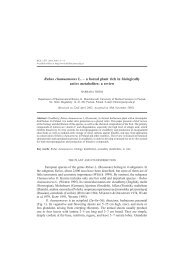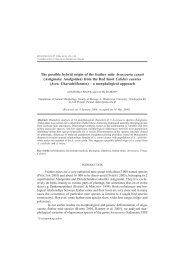Efficacy of new-generation acaricides in controlling mites in apple ...
Efficacy of new-generation acaricides in controlling mites in apple ...
Efficacy of new-generation acaricides in controlling mites in apple ...
Create successful ePaper yourself
Turn your PDF publications into a flip-book with our unique Google optimized e-Paper software.
BIOLOGICAL LETT. 2006, 43(2): 347–351<br />
Available onl<strong>in</strong>e at http://www.biollett.amu.edu.pl<br />
EFFICACY OF NEW-GENERATION ACARICIDES<br />
<strong>Efficacy</strong> <strong>of</strong> <strong>new</strong>-<strong>generation</strong> <strong>acaricides</strong> <strong>in</strong> controll<strong>in</strong>g <strong>mites</strong><br />
<strong>in</strong> <strong>apple</strong> and plum orchards<br />
ALICJA MACIESIAK and REMIGIUSZ W. OLSZAK<br />
Research Institute <strong>of</strong> Pomology and Floriculture, Pomologiczna 18,<br />
96-100 Skierniewice, Poland; e-mail: mtart@<strong>in</strong>sad.pl<br />
(Received on 13 January 2006, Accepted on 6 November 2006)<br />
347<br />
Abstract: The effectiveness <strong>of</strong> <strong>acaricides</strong>: Envidor 240 SC (spirodicl<strong>of</strong>en) and Milbeknock EC<br />
(mibemect<strong>in</strong>) <strong>in</strong> controll<strong>in</strong>g <strong>mites</strong> <strong>in</strong> commercial <strong>apple</strong> and plum orchards was evaluated <strong>in</strong> 2001–2004<br />
<strong>in</strong> various localities. In all experiments, Milbeknock EC and Envidor 240 SC showed very high and longlast<strong>in</strong>g<br />
efficacy <strong>in</strong> controll<strong>in</strong>g <strong>mites</strong> on <strong>apple</strong> and plum trees. Dur<strong>in</strong>g 6–12 weeks follow<strong>in</strong>g the treatment,<br />
the mite population did not exceed the economical threshold level.<br />
Key words: <strong>mites</strong>, <strong>acaricides</strong>, Milbeknock EC, Envidor 240 SC<br />
INTRODUCTION<br />
Mites <strong>in</strong> orchards have been dangerous for a long time. Through suck<strong>in</strong>g out<br />
sap from leaves, spider <strong>mites</strong> reduce the level <strong>of</strong> photosynthesis and disturb transpiration.<br />
The <strong>in</strong>fested trees lose their leaves earlier than normally, the fruits are small<br />
and acid, and the crop yield is reduced. Markedly affected trees also reduce the number<br />
<strong>of</strong> flower buds set for the next year and are more susceptible to frost (GOLIK 1975).<br />
Chemical control should be applied very <strong>of</strong>ten, when mite density is at or above the<br />
economic threshold level. <strong>Efficacy</strong> <strong>of</strong> various preparations for control <strong>of</strong> the <strong>mites</strong><br />
have been <strong>in</strong>vestigated by many authors (SMOLARZ 1990, SMOLARZ et al. 1990,<br />
MACIESIAK & OLSZAK 2001). Adjustment to the rules obligatory <strong>in</strong> the European<br />
Union has resulted <strong>in</strong> withdrawal <strong>of</strong> some active compounds from pest control <strong>in</strong><br />
Poland (CZAPLICKI 2003). The products conta<strong>in</strong><strong>in</strong>g amitraz (Mitac 200 EC, Samba<br />
200 EC, Acaritox 200 EC) were elim<strong>in</strong>ated from the Polish register <strong>of</strong> <strong>acaricides</strong> <strong>in</strong><br />
2005. Other compounds can also be rejected until 2008. Test<strong>in</strong>g <strong>of</strong> <strong>new</strong>, modern<br />
<strong>acaricides</strong> is thus needed. This study aimed to evaluate some <strong>new</strong>-<strong>generation</strong> <strong>acaricides</strong><br />
(Envidor 240 SC and Milbeknock EC) for control <strong>of</strong> <strong>mites</strong> on <strong>apple</strong> and plum<br />
trees. The efficacy <strong>of</strong> these compounds has not been tested so far <strong>in</strong> commercial<br />
orchards <strong>in</strong> Poland. However, the product Envidor 240 EC has proved useful for<br />
control <strong>of</strong> two-spotted spider <strong>mites</strong> on currants (£ABANOWSKA 2002).
348 Alicja Maciesiak and Ryszard W. Olszak<br />
MATERIAL AND METHODS<br />
The experiments were conducted <strong>in</strong> 2001–2004 <strong>in</strong> several commercial orchards<br />
<strong>in</strong> some regions <strong>of</strong> Poland. The effectiveness <strong>of</strong> the <strong>new</strong> <strong>acaricides</strong> Envidor 240 SC<br />
(spirodicl<strong>of</strong>en) and Milbeknock EC (mibemect<strong>in</strong>) was compared with the standard<br />
preparations Mitac 200 EC (amitraz), Omite 30 WP (propargite), Ortus 05 SC (fenpyroximate).<br />
The experiments, conducted <strong>in</strong> 4 replicates, were set up <strong>in</strong> a block design<br />
with plots <strong>of</strong> 0.1–0.3 ha each as a comb<strong>in</strong>ation. Treatments were performed with a<br />
tractor sprayer us<strong>in</strong>g 600–750 l <strong>of</strong> spray<strong>in</strong>g liquid per ha. Mobile forms <strong>of</strong> spider<br />
<strong>mites</strong> were counted on leaves sampled from the external part <strong>of</strong> the crown <strong>of</strong> trees<br />
grow<strong>in</strong>g <strong>in</strong> the middle part <strong>of</strong> the plot. Population density was evaluated with HEN-<br />
DERSON & MCBURNIE’s (1943) method on 50 leaves for each replicate and date. A<br />
n=<br />
k−1<br />
t n<br />
cumulative <strong>in</strong>dex <strong>of</strong> <strong>in</strong>festation (CII = ∑ ( ⋅(<br />
x ))<br />
= 1<br />
n + x<br />
n<br />
n+<br />
1 mite unit days where k<br />
2<br />
is the number <strong>of</strong> occasions on which the <strong>mites</strong> were counted; n , n+<br />
1 are consecutive<br />
<strong>in</strong>dices; is the time, <strong>in</strong> days, between the consecutive <strong>in</strong>dices )<br />
(WRATTEN et al. 1979) was calculated for each test. The results were subjected to an<br />
analysis <strong>of</strong> variance. Duncan’s t test was employed to evaluate the significance <strong>of</strong><br />
differences at P=0.05.<br />
x x<br />
t n<br />
n , n+<br />
1 x x<br />
2<br />
Table 1. Effectiveness <strong>of</strong> Envidor 240 SC and Milbeknock EC <strong>in</strong> controll<strong>in</strong>g <strong>mites</strong> on <strong>apple</strong> trees (2001–<br />
2002)<br />
Treatment<br />
Rate/ha<br />
Mean no. <strong>of</strong> <strong>mites</strong> per leaf<br />
Weeks after treatment<br />
3–4 5–6 7–8 11–12<br />
Location A – Grzymkowice, near Grójec, spray<strong>in</strong>g date 17 May 2001<br />
Envidor 240 SC - 0.4 l 0.0 a* 0.0 a 0.0 a 0.1 a 0.5 a<br />
Milbeknock EC - 1.0 l 0.0 a 0.0 a 0.1 a 0.0 a 1.7 ab<br />
Omite 30 WP - 2.25 kg 0.3 b 0.02 a 0.05 a 0.5 a 5.1 b<br />
Control 1.9 c 4.7 b 3.1 b 3.3 b 100.0 c<br />
Location B – Wilcze Piêtki, near Grójec, spray<strong>in</strong>g date 25 May 2001<br />
Envidor 240 SC - 0.4 l 0.0 a 0.0 a 0.0 a 0.1 a 0.6 a<br />
Milbeknock EC - 1.0 l 0.01 a 0.0 a 0.0 a 0.1 a 1.0 a<br />
Omite 30 WP - 2.25 kg 0.5 b 0.0 a 0.8 ab 1.3 b 26.6 b<br />
Control 0.4 b 1.1 b 3.0 c 3.6 c 100.0 c<br />
Location C – Muchnice, near Kutno, spray<strong>in</strong>g date 10 May 2002<br />
Milbeknock EC - 0.75 l 0.6 b 0.4 b 0.3 a – 4.5 a<br />
Milbeknock EC - 1.0 l 0.1 a 0.02 a 0.1 a – 1.2 a<br />
Ortus 05 SC - 1.5 0.1 a 0.7 b 2.4 b – 8.6 a<br />
Control 18.8 c 10.8 c 12.1 c – 100.0 b<br />
Location D – Nowa Wieœ, near Grójec, spray<strong>in</strong>g date 9 May 2002<br />
Milbeknock EC - 0.75 l 0.03 a 0.0 a 0.02 a – 0.8 a<br />
Milbeknock EC - 1.0 l 0.05 a 0.0 a 0.0 a – 0.5 a<br />
Ortus 05 SC - 1.5 l 0.0 a 0.0 a 0.0 a – 0.0 a<br />
Control 8.7 b 1.7 b 3.8 b – 100.0 b<br />
CII – cumulative <strong>in</strong>dex <strong>of</strong> <strong>in</strong>festation (control = 100%)<br />
* Means followed by the same letter with<strong>in</strong> columns do not differ significantly at P=0.05<br />
CII<br />
(%)
Treatment<br />
Rate (kg/ha)<br />
EFFICACY OF NEW-GENERATION ACARICIDES<br />
RESULTS AND DISCUSSION<br />
Table 2. Effectiveness <strong>of</strong> Envidor 240 SC and Milbeknock EC <strong>in</strong> controll<strong>in</strong>g <strong>mites</strong> on <strong>apple</strong> trees (2003–<br />
2004)<br />
Mean no. <strong>of</strong> <strong>mites</strong> per leaf<br />
Weeks after treatment<br />
2 4 6 8<br />
Location E – Wilcze Piêtki, near Grójec, spray<strong>in</strong>g date 4 June 2003<br />
Milbeknock EC -0.75 l 0.0* 0.1 ab 0.1 ab 0.1 ab 3.2 ab<br />
Milbeknock EC - 1.0 l 0.0 a 0.05 a 0.0 a 0.02 a 2.6 a<br />
Ortus 05 SC - 1.0 l 0.0 a 0.1 ab 0.0 a 0.0 a 1.2 a<br />
Control 1.7 b 2.8 c 3.8 c 7.0 c 100.0 c<br />
Location F – Lewiczyn, near Grójec, spray<strong>in</strong>g date 27 April 2004<br />
Envidor 240 SC - 0.3 l 0.0 a 0.0 a 0.0 a 0.02 a 0.02 a<br />
Envidor 240 SC - 0.4 l 0.0 a 0.0 a 0.0 a 0.0 a 0.0 a<br />
Milbeknock EC - 0.75 l 0.0 a 0.02 a 0.0 a 1.3 b 0.8 a<br />
Milbeknock EC - 1.0 l 0.0 a 0.05 a 0.0 a 0.2 a 0.2 a<br />
Mitac 200 EC - 3.0 l 0.0 a 1.4 b 1.1 b 21.0 c 12.6 a<br />
Control 4.1 b 25.1 c 8.1 c 18.3 c 100.0 b<br />
Location G – Pêsy, near P³oñsk, spray<strong>in</strong>g date 28 April 2004<br />
Envidor 240 SC - 0.3 l 0.3 b 0.2 b 0.1 a 5.2 cd 13.3 b<br />
Envidor 240 SC - 0.4 l 0.1 ab 0.9 c 0.1 a 0.6 b 6.4 ab<br />
Milbeknock EC - 0.75 l 0.0 a 0.0 a 0.0 a 0.1 b 0.2 a<br />
Milbeknock EC - 1.0 l 0.0 a 0.0 a 0.0 a 0.0 a 0.0 a<br />
Mitac 200 EC - 3.0 l 0.0 a 0.02 a 0.02 a 0.0 a 0.3 a<br />
Control 5.7 b 7.9 c 5.9 b 18.2 d 100.0 b<br />
CII – cumulative <strong>in</strong>dex <strong>of</strong> <strong>in</strong>festation (control = 100%)<br />
* Means followed by the same letter with<strong>in</strong> columns do not differ significantly at P=0.05<br />
CII<br />
(%)<br />
349<br />
The <strong>acaricides</strong> Envidor 240 SC and Milbeknock EC <strong>in</strong> all experiments was very<br />
effective on <strong>apple</strong> (Tables 1, 2) and plum tress (Table 3). The mite population on<br />
<strong>apple</strong> leaves sprayed with this acaricide rema<strong>in</strong>ed below the economical threshold<br />
level (3 active stages <strong>of</strong> <strong>mites</strong> per leaf <strong>in</strong> the spr<strong>in</strong>g, and 5-7 <strong>mites</strong> per leaf <strong>in</strong> the<br />
summer) dur<strong>in</strong>g 8–12 weeks after treatment. A similar effect was obta<strong>in</strong>ed with the<br />
tested standard <strong>acaricides</strong>. At locations A and B (Table 1) on trees treated with Envidor<br />
240 SC and Milbeknock EC as well as with Omite 30 WP as the standard<br />
product, the density <strong>of</strong> spider <strong>mites</strong> was low dur<strong>in</strong>g the whole observation period<br />
(until 11–12 weeks after the treatment). At location D (Table 1) as well as at location<br />
E (Table 2), no spider <strong>mites</strong> were recorded dur<strong>in</strong>g 7-8 weeks after treatment with<br />
Milbeknock EC (0.75 l/ha and 1 l/ha) and the standard Ortus 05 SC. At location C<br />
an application <strong>of</strong> Milbeknock EC resulted <strong>in</strong> a very low density <strong>of</strong> the spider mite<br />
population dur<strong>in</strong>g the follow<strong>in</strong>g 7–8 weeks <strong>of</strong> observation, while the standard Ortus<br />
05 SC showed a somewhat shorter activity period (6 weeks). The products Envidor<br />
240 EC and Milbeknock EC applied at location F kept the density <strong>of</strong> spider <strong>mites</strong> at<br />
a low level dur<strong>in</strong>g 8 subsequent weeks <strong>of</strong> observation. The standard product Mitac<br />
200 EC showed a good activity dur<strong>in</strong>g 6 weeks after the treatment. However, 2 weeks<br />
later the densities <strong>of</strong> spider <strong>mites</strong> were high and comparable to the control. At location<br />
F the activity <strong>of</strong> Envidor 240 EC at a dose <strong>of</strong> 0.4 l/ha and Milbeknock EC on all
350 Alicja Maciesiak and Ryszard W. Olszak<br />
Table 3. Effectiveness <strong>of</strong> Envidor 240 SC and Milbeknock EC <strong>in</strong> controll<strong>in</strong>g <strong>mites</strong> on plum trees (2003–<br />
2004)<br />
Treatment Rate<br />
(kg/ha)<br />
Mean no. <strong>of</strong> <strong>mites</strong> per leaf<br />
Weeks after treatment<br />
2 5 7 9<br />
Location H – Ostrowiec, spray<strong>in</strong>g date 3 June 2003<br />
Envidor 240 SC 0.4 0.0 a* 0.0 a 0.0 a 0.1 a 0.5 a<br />
Milbeknock EC 0.75 0.0 a 0.02 a 0.0 a 0.02 a 0.2 a<br />
Milbeknock EC 1.0 0.0 a 0.02 a 0.0 a 0.0 a 0.2 a<br />
Mitac 200 EC 3.0 0.0 a 0.5 b 3.7 b 13.6 b 37.1 b<br />
Control – 0.6 b 4.1 c 14.5 c 21.7 b 100.0 c<br />
Location I – Mi³ob¹dz, spray<strong>in</strong>g date 16 July 2003<br />
Envidor 240 SC 0.4 0.3 a 0.7 a 0.05 a 0.1 a 1.8 a<br />
Milbeknock EC 0.75 4.3 b 2.8 a 2.8 b 1.4 b 14.2 b<br />
Milbeknock EC 1.0 2.4 a 1.6 a 0.3 a 0.3 a 5.7 a<br />
Mitac 200 EC 3.0 3.0 a 4.0 b 0.5 a 0.9 a 10.9 b<br />
Control – 25.6 c 20.9 c 17.4 c 18.8 c 100.0 c<br />
Location J – Ostrowiec, spray<strong>in</strong>g date 30 June 2004<br />
2 3 4 5 6<br />
Envidor 240 SC 0.4 0.03 a 0.0 a 0.8 a 1.3 a 0.1 a 8.9 a<br />
Milbeknock EC 0.75 0.02 a 0.0 a 1.1 ab 0.9 a 0.05 a 9.4 a<br />
Milbeknock EC 1.0 0.0 a 0.04 a 0.9 a 1.0 a 0.0 a 9.4 a<br />
Mitac 200 EC 3.0 0.05 a 3.7 b 2.4 bc 1.0 a 0.4 b 34.4 b<br />
Control – 15.4 b 8.3 c 3.1 c 4.0 b 4.7 c 100.0c<br />
CII – cumulative <strong>in</strong>dex <strong>of</strong> <strong>in</strong>festation (control = 100%)<br />
* Means followed by the same letter with<strong>in</strong> columns do not differ significantly at P=0.05<br />
dates <strong>of</strong> observation was similar to that <strong>of</strong> the standard Mitac 200 EC. In the same<br />
orchard, Envidor SC applied at a dose <strong>of</strong> 0.3 l/ha was effective for a shorter time.<br />
The products Envidor 240 EC as well as Milbeknock EC showed also a high efficacy<br />
<strong>in</strong> plum orchards (Table 3). Their application resulted <strong>in</strong> a very low density <strong>of</strong><br />
spider <strong>mites</strong> on all dates <strong>of</strong> observation, comparable with that obta<strong>in</strong>ed on trees treated<br />
with the standard Mitac 200 EC at locations H and J(2004). At location H(2003),<br />
however, the activity <strong>of</strong> Envidor 240 EC and Milbeknock EC was much better than<br />
that <strong>of</strong> the standard Mitac 200 EC. The products Envidor 240 SC and Milbeknock<br />
EC have demonstrated a high efficacy <strong>in</strong> controll<strong>in</strong>g spider <strong>mites</strong> <strong>in</strong> <strong>apple</strong> and plum<br />
orchards. They can thus replace the products conta<strong>in</strong><strong>in</strong>g amitraz, withdrawn from the<br />
market already, or the ones that can be withdrawn <strong>in</strong> the near future.<br />
CONCLUSIONS<br />
The high effectiveness <strong>of</strong> Envidor 240 SC (spirodicl<strong>of</strong>en) and Milbeknock EC<br />
(mibemect<strong>in</strong>) and their long-last<strong>in</strong>g action justifies their recommendation for practical<br />
use.<br />
CII<br />
(%)
EFFICACY OF NEW-GENERATION ACARICIDES<br />
REFERENCES<br />
351<br />
CZAPLICKI E. 2003. Re-exam<strong>in</strong>ation <strong>of</strong> “exist<strong>in</strong>g” active substances <strong>in</strong> European Union, procedure<br />
ECCO peer review meet<strong>in</strong>gs, expectations and requirements <strong>in</strong> Poland. Prog. Plant Protect.<br />
43: 69–77.<br />
GOLIK Z. 1975. A study <strong>of</strong> the destructiveness <strong>of</strong> the fruit tree red spider mite, Panonychus ulmi<br />
(Koch) on <strong>apple</strong>. Zesz. Probl. Post. Naul Rol. 171: 15–34.<br />
HENDERSON C. F., MCBURNIE H. V. 1943. Sampl<strong>in</strong>g technique for determ<strong>in</strong><strong>in</strong>g populations <strong>of</strong> the<br />
citrus red mite and its predators. USDA Circ. 671: 1–11.<br />
£ABANOWSKA B. H. 2002. <strong>Efficacy</strong> <strong>of</strong> Envidor 240 SC <strong>in</strong> the control <strong>of</strong> the twospotted spider mite<br />
(Tetranychus urticae Koch) on the black currant plantations <strong>in</strong> Poland. Proc. 8th IS on Rubus<br />
and Ribes, (BRENNAN R. M., Ed.), Acta Hort., ISHS 2002: 363–367.<br />
MACIESIAK A., OLSZAK R. 2001. Nowe akarycydy w zwalczaniu przêdziorków w sadach [New<br />
<strong>acaricides</strong> for control <strong>of</strong> red spider <strong>mites</strong> <strong>in</strong> orchards]. Prog. Plant Protec. 41: 160–163.<br />
SMOLARZ S. 1990. Effectiveness <strong>of</strong> cl<strong>of</strong>entez<strong>in</strong>e and hexythiazox <strong>in</strong> the control <strong>of</strong> the fruit tree<br />
spider mite (Panonychus ulmi Koch). Fruit Sci. Rep. 17/4: 193–202.<br />
SMOLARZ S., SUSKI Z., KOBIELA B. 1990. Control <strong>of</strong> the fruit tree red mite Panonychus ulmi Koch<br />
with fenpropathr<strong>in</strong> and flucythr<strong>in</strong>ate <strong>in</strong> <strong>apple</strong> orchard. Zesz. Probl. Post. Nauk Rol. 373: 55–62.<br />
WRATTEN S. D., LEE G., STEVENS D. J. 1979. Duration <strong>of</strong> cereal aphid populations and the effects<br />
on wheat yield and quality. Proc. British Crop. Protec. Conf. 1: 1–8.<br />
Associate editor: ANNA SKORACKA





